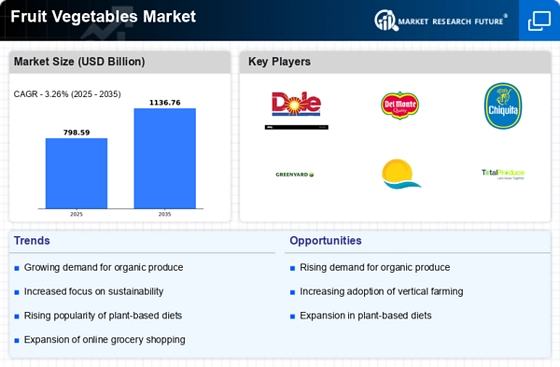Changing Dietary Preferences
The shift towards plant-based diets is significantly influencing the Fruit Vegetables Market. As more individuals adopt vegetarian or vegan lifestyles, the demand for fruits and vegetables is surging. This trend is supported by a growing body of research linking plant-based diets to various health benefits, including lower risks of chronic diseases. In 2025, it is projected that the consumption of fruits and vegetables will increase by approximately 10% as more consumers seek to incorporate these foods into their diets. This change in dietary preferences is prompting food manufacturers to innovate and create new products that cater to this market segment, thereby driving growth within the Fruit Vegetables Market. The emphasis on plant-based nutrition is likely to persist, further solidifying the role of fruits and vegetables in daily diets.
Increased Focus on Food Safety
Food safety concerns are becoming increasingly prominent, thereby influencing the Fruit Vegetables Market. Consumers are more vigilant about the origins and handling of their food, leading to a demand for transparency in the supply chain. In 2025, it is anticipated that approximately 70% of consumers will prioritize food safety when making purchasing decisions. This heightened awareness is prompting producers and retailers to adopt stricter safety protocols and certifications, which can enhance consumer trust. As a result, the Fruit Vegetables Market is likely to see a rise in demand for products that are certified safe and traceable. This focus on food safety not only addresses consumer concerns but also aligns with regulatory requirements, further driving growth in the market.
Expansion of E-commerce Platforms
The rise of e-commerce is reshaping the Fruit Vegetables Market, providing consumers with greater access to a variety of products. Online grocery shopping has gained traction, particularly among younger demographics who prefer the convenience of home delivery. In 2025, it is estimated that online sales of fruits and vegetables will account for nearly 25% of total sales in the market. This shift is encouraging traditional retailers to enhance their online presence and invest in logistics to meet consumer demands. The expansion of e-commerce platforms not only facilitates access to fresh produce but also allows for a broader range of products, including organic and specialty items. As this trend continues, it is likely to drive further growth and innovation within the Fruit Vegetables Market.
Rising Demand for Organic Produce
The increasing consumer preference for organic products is a notable driver in the Fruit Vegetables Market. As health awareness escalates, consumers are gravitating towards organic fruits and vegetables, which are perceived as healthier alternatives. In 2025, the organic produce segment is projected to account for approximately 15% of the total fruit and vegetable market. This shift is not merely a trend but reflects a deeper understanding of the benefits associated with organic farming practices, such as reduced pesticide exposure and enhanced nutritional value. Retailers are responding by expanding their organic offerings, thereby stimulating growth within the Fruit Vegetables Market. This demand is likely to continue as consumers become more educated about food sources and their impacts on health.
Technological Advancements in Agriculture
Technological innovations are transforming the Fruit Vegetables Market, enhancing productivity and efficiency. Precision agriculture, which utilizes data analytics and IoT devices, is becoming increasingly prevalent. These technologies enable farmers to optimize resource use, monitor crop health, and improve yield quality. For instance, the adoption of drones for crop monitoring and automated irrigation systems is on the rise. In 2025, it is estimated that technology-driven practices could increase crop yields by up to 20%. This not only supports the growing demand for fruits and vegetables but also contributes to sustainability efforts by minimizing waste and resource consumption. As these technologies become more accessible, they are likely to play a crucial role in shaping the future of the Fruit Vegetables Market.

















Leave a Comment